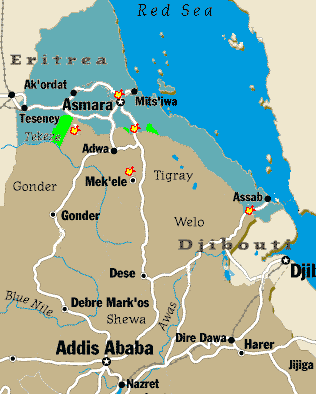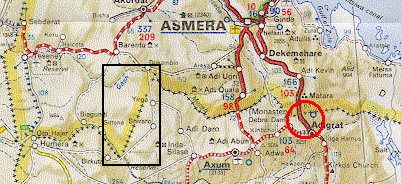News
Stories![]() ( See URL-Minder )
( See URL-Minder )
| Relations
between Ethiopia and Eritrea Border Dispute On May 6, Eritrean
troops took over the border town of Badame, southwest of Asmara,
after a skirmish between Ethiopian police units and armed men
from Eritrea, according to Ethiopian officials.
The ultimate fates of Ethiopia Outside interests |
Inside interests: (conflicts involving communal groups)
Meles member of the northern Tigray minority who has promoted ethnic-based federalism and pays lip service to a multiparty system, has been harshly criticized by Ethiopia's majority Amharas and Oromos for giving up Eritrea -- and its Red Sea ports of Assab and Massawa -- in return for Isaias' help.
Afars live in Ethiopia and Djibouti (35%) in addition to Eritrea .The Afar populations were most directly affected by the separation of Eritrea from the Ethiopian state. Many Afars were reluctant to accept an independent Eritrea since it divides their people between Eritrea and Ethiopia. Some Afars may now feel that they can only expect to fulfil their aspirations of unity through armed conflict like that taking place in Djibouti over similar issues. Since they are a nomadic people, their lifestyle requires seasonal movements, and since they have been used to moving throughout the region, the creation of national boundaries over the past few years has negatively affected their quality of life.Ethiopia's new policy of ethnic federalism opens an unprecedented opportunity to the Afar people to leave behind the chronic instability, economic stagnation, and neglect that have characterised the region's past. The Ethiopia's Afar population is today consolidated for the first time within a single province with autonomous powers of self-government.
ETHIOPIA [ AFARS ][ OROMO ][ SOMALIS ][ TIGREAN ][ AMHARA ]
ERITREA [ AFARS ]
 Eritrean rebels were instrumental in helping
the Ethiopian People's Revolutionary Democratic Front overthrow
a 17 year military regime in July 1991 (see
Eritrean rebels were instrumental in helping
the Ethiopian People's Revolutionary Democratic Front overthrow
a 17 year military regime in July 1991 (see  six areas, Setit Mareb Bada
Zoba Debubawi Keyih Bahri Badime(Yirga)
areas
six areas, Setit Mareb Bada
Zoba Debubawi Keyih Bahri Badime(Yirga)
areas